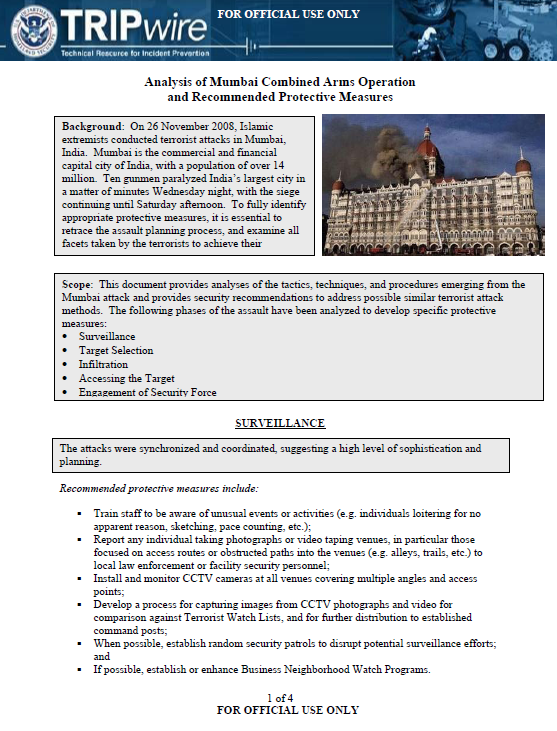 DHS TRIPwire Report
DHS TRIPwire Report
- 4 pages
- For Official Use Only
- December 6, 2008
Background: On 26 November 2008, Islamic extremists conducted terrorist attacks in Mumbai, India. Mumbai is the commercial and financial capital city of India, with a population of over 14 million. Ten gunmen paralyzed India’s largest city in a matter of minutes Wednesday night, with the siege continuing until Saturday afternoon. To fully identify appropriate protective measures, it is essential to retrace the assault planning process, and examine all facets taken by the terrorists to achieve their
Scope: This document provides analyses of the tactics, techniques, and procedures emerging from the Mumbai attack and provides security recommendations to address possible similar terrorist attack methods. The following phases of the assault have been analyzed to develop specific protective measures:
• Surveillance
• Target Selection
• Infiltration
• Accessing the Target
• Engagement of Security Force
Analysis of Mumbai Combined Arms Operation and Recommended Protective MeasuresSURVEILLANCE
The attacks were synchronized and coordinated, suggesting a high level of sophistication and planning.
Recommended protective measures include:
- Train staff to be aware of unusual events or activities (e.g. individuals loitering for no apparent reason, sketching, pace counting, etc.);
- Report any individual taking photographs or video taping venues, in particular those focused on access routes or obstructed paths into the venues (e.g. alleys, trails, etc.) to local law enforcement or facility security personnel;
- Install and monitor CCTV cameras at all venues covering multiple angles and access points;
- Develop a process for capturing images from CCTV photographs and video for comparison against Terrorist Watch Lists, and for further distribution to established command posts;
- When possible, establish random security patrols to disrupt potential surveillance efforts; and
- If possible, establish or enhance Business Neighborhood Watch Programs.
TARGET SELECTION
The main attack focused on less secure, high visibility commercial facilities frequented by Western citizens. Targets included five-star hotels catering to international business and tourists;a popular restaurant for backpackers and Western travelers; a Jewish Community Center; and crowded transportation terminals. Other sites included a movie theater, police station, and hospital. Witness reports indicate that the terrorists appeared to be familiar with layouts of the target sites.
Recommended protective measures include:
- Establish security at venue access points and potential approach routes;
- If possible, randomly alter delivery entrances to venues to avoid developing discernable patterns;
- Avoid widely distributing site blueprints or schematics and ensure those documents are kept secured;
- Prepare for upcoming facility or area special events and dignitary visits; and
- Know facilities’ vendors.
INFILTRATION
The terrorists used a fishing vessel and small ships to gain access to Mumbai armed with small arms, grenades and explosives, allowing them to circumvent security checkpoints. Inflatable rafts carried terrorist teams to India Gateway and/or Badwhar Park at 9 p.m. local time. The lax security along Mumbai’s coastline gave the heavily armed assailants simple, direct, and covert access to the heart of the city. Land route entry would have posed logistical problems due to infamous Mumbai traffic, and heavily monitored train stations.
Recommended protective measures include:
- If a maritime approach is a feasible method of attack, deploy adequate harbor patrols and ensure increased awareness;
- Establish or reinforce surveillance detection and awareness programs for water-front businesses and residents to identify and report unusual activity;
- Encourage local population to report unusual behavior to increase vigilance and reporting;
- When a maritime threat exists, establish check points or other access control measures for all vessels;
- Require all vessels to positively identify themselves prior to entering the port area; and
- Increase planning, exercises, and coordination between the Captain of the Port and Federal, State and local law enforcement agencies.

